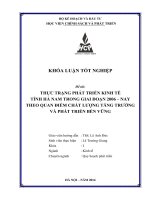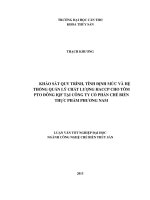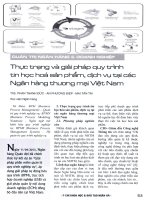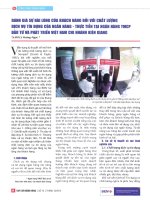CX KPIs updated Công thức tính KPI cho CXM
Bạn đang xem bản rút gọn của tài liệu. Xem và tải ngay bản đầy đủ của tài liệu tại đây (90.34 KB, 3 trang )
The ROI of Customer Experience: 16 KPIs You Should Be Tracking
Customer Lifetime Value (CLV)
CLV is a projection of the amount of revenue a single
customer will generate for a business over the
duration of time they remain a customer.
CLV
=
($)
Avg. Sale Price per Customer x Avg. # of
Times Customer Buys per Month
Monthly Customer Churn Rate
* Increases in customer lifetime value lead to
increased customer retention, more revenue
generated per customer, and less marketing dollars
spent attracting new customers.
Customer Acquisition Cost (CAC)
CAC is the amount of money spent to acquire a new
customer.
CAC
=
($)
Sales & Marketing Costs
# of New Customers Acquired
* A study by American Express showed that on
average one happy customer can equal nine
referrals for your business.
Take a look at CAC compared to CLV. If CAC is
much higher, think about how to increase the
value of the interactions that occur after a customer
has been acquired, rather than the effort it takes to
acquire a new one.
Up-Sell and Cross-Sell Rate
The percentage of people who purchase an add-on
or upgrade to a product or service. An Up-Sell refers
to a sale that is more expensive than the customer
originally intended on purchasing, whereas a
Cross-Sell refers to the sale of a different product or
service to an existing customer.
Up-Sell /
Cross-Sell =
Rate
(%)
# of People Who Purchase Add-On or Upgrade
Total # of Transactions
* Customers who have a better experience spend
more with a company. A Forrester report says
customers who have a high-quality experience are
3.6 times more likely to buy additional products and
services from a brand.
Average Order Value (AOV)
AOV is the average amount a customer spends in a
specific customer group when purchasing a product
or service.
AOV
=
($)
Sales Revenue
Total # of Sales Transactions
* AOV has a clear impact on the bottom line as an
increase or decrease directly affects revenue and
business growth. To increase AOV, businesses need
to find more ways to generate valuable
experiences by having a clear view of what matters
most to customers.
Conversion Rate
The percentage of total visitors or prospective
transactions who end up completing a sale.
Conversion
Rate =
(%)
# of Completed Sales Transactions
Total # of Interactions Handled
* Customers want the buying experience to be easy,
the more effort required on their end, the less likely
they are to convert.
Average Revenue per Customer (ARPC)
ARPC is the number of sales generated per customer
during a specific period.
ARPC
=
($)
Sales Revenue
Total # of Customers
* Similar to AOV, ARPC is a clear indicator of how
much value each customer provides to a business,
and how much that value is growing overtime.
BE ONE STEP AHEAD
w intouchinsight.com
The ROI of Customer Experience: 16 KPIs You Should Be Tracking
Net Promoter Score (NPS)
NPS is a customer feedback tool that measures client
satisfaction and loyalty to a brand. NPS data is
gathered through a single survey question on an
answer scale of 0-10. NPS scores can range from -100
to +100.
NPS =
% of Promoters - % of Detractors
* Promoters are customers who are devoted to a
brand; they are the bread and butter of a business.
Passives are often happy customers but are
indifferent to the products or services and less loyal
than promoters. Detractors are customers who are
not satisfied and will likely not remain long-term.
Customer Churn Rate
The percentage of customers who do not return to a
company after making a purchase either by not
making a repeat purchase or by canceling their
service during a specific period.
Churn
Rate =
(%)
# of Lost Customers
# of Active Customers
* Customer churn can mean the percentage of
customers who don’t return to a business, people
who unsubsubscribe from an email list, or unfollows
on social media.
Customer Effort Score (CES)
CES is measured through a customer satisfaction
survey to determine the amount of effort a customer
required to accomplish a task. Typically measured on
a defined number scale from 1-7 through a post-interaction survey. A CES score of 1 indicates high effort.
CES =
(%)
Total # of Respondents who agree (5 or above)
Total # of respondents surveyed
* The customer effort score is a highly actionable
piece of customer feedback as it provides insights
around a specific event or circumstance along the
customer journey.
Customer Satisfaction (CSAT)
CSAT is typically measured through a customer feedback survey represented on a scale of 0 to 100 percent. A typical answer scale is scored from 1 to 7, only
customers who rated 5 or above should be included
as a satisfied customer.
CSAT
=
(%)
# of Satisfied Customers (5 or above)
Total # of Satisfaction Survey Responses
* Measuring customer satisfaction is crucial to
ensuring brand standards are aligned with customer
expectations and is useful for uncovering customer
pain points.
Customer Retention Rate
The percentage of customers who remain with a
company over a period.
Retention
Rate =
(%)
# of Customers at End of Period - # of New Customers Acquired During Period
# of Customers at Start of Period
* Similar to customer churn rate, customer retention is
extremely valuable for company growth. Research
indicates that a 5% increase in customer retention
can increase company revenue by 25-95%.
Net Emotion Score (NES)
NES is the difference between positive and negative
emotions associated with a product, service, or brand.
Positive emotions are associated with feelings such
as happiness, pleasure, and trust. Whereas negative
emotions are associated with feelings such as
dissatisfaction, frustration, and neglect.
NES = Avg. of Positive Emotions - Avg. of Negative Emotions
* The idea is to determine which emotions best reflect
a brands values and represent a competitive
differentiator. Use the NES to measure these
emotions to determine the level of value being
provided to customers.
BE ONE STEP AHEAD
w intouchinsight.com
The ROI of Customer Experience: 16 KPIs You Should Be Tracking
Problem Resolution Time (PRT)
The average amount of interactions it takes between
customer and company to resolve an issue.
Cost per Interaction / Activity
The business cost required to process or handle a
given item. Might be a call, contact, interaction, order,
click, etc.
Sum of All Interactions for Total Resolved Issues
PRT =
Total # of Resolved Issues
Cost per
Interaction =
($)
$ Invested in Each Activity (Call, Order, etc.)
Total # of Associated Activites
* Assess how many interactions are necessary to
resolve a customer issue and then compare that
to the current PRT. If the amount of interactions far
exceeds the appropriate amount of time, customers
are likely encountering difficulty along their way.
* If the efficiency in which customer problems are
handled improves, the time it takes to handle a
customer problem will likely go down, and the cost
associated to that interaction will also go down.
First Response Time (FRT)
First Contact Resolution (FCR) Rate
The average amount of time between when a
customer submits a case and the time customer
support responds (generally measured in minutes
during business hours).
Sum of All First Response Times
FRT =
Total # of Cases Resolved
* According to a CX impact report, 50 percent of
consumers give a brand only one week to respond
to a question before they stop doing business with
them. This is why it is critical for organizations to
solve customer problems in a quick and sincere
manner.
The percentage of customers whose question or
request is resolved on the first attempt. Typically
measured through a post-interaction survey asking
the customer if their issue has been resolved.
FCR
(%) =
# of Incidents Resolved on First Contact
Total # of Incidents
* A CX impact reports indicates that 89% of
customers get frustrated because they need to
repeat their issues to multiple representatives. This
frustration can escalate to a lost customer.
BE ONE STEP AHEAD
w intouchinsight.com









